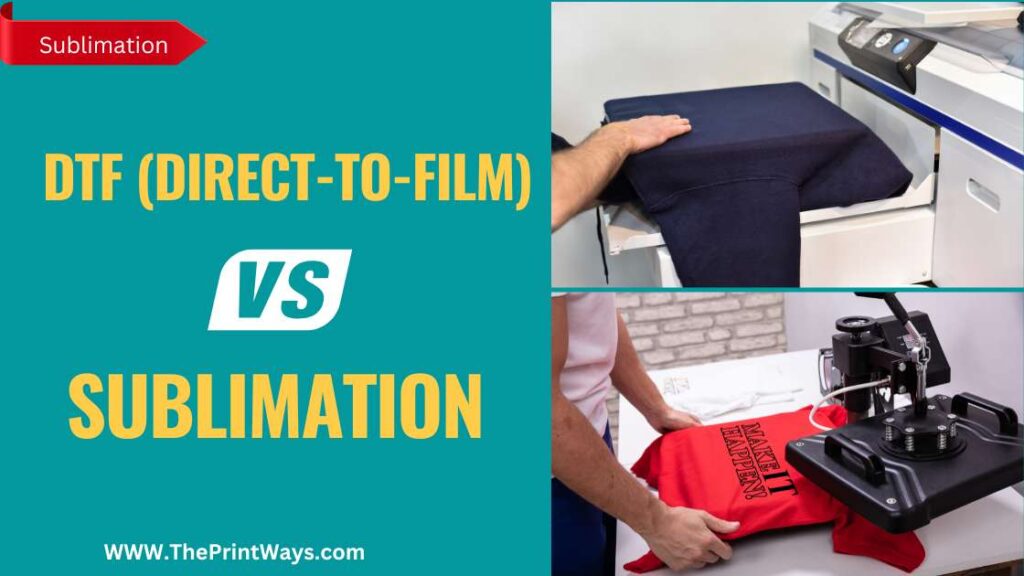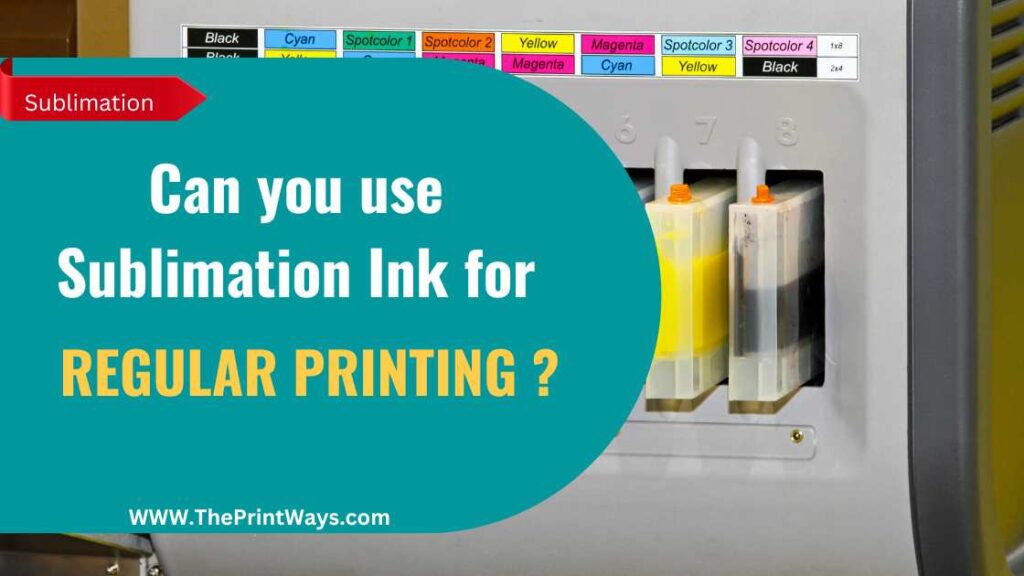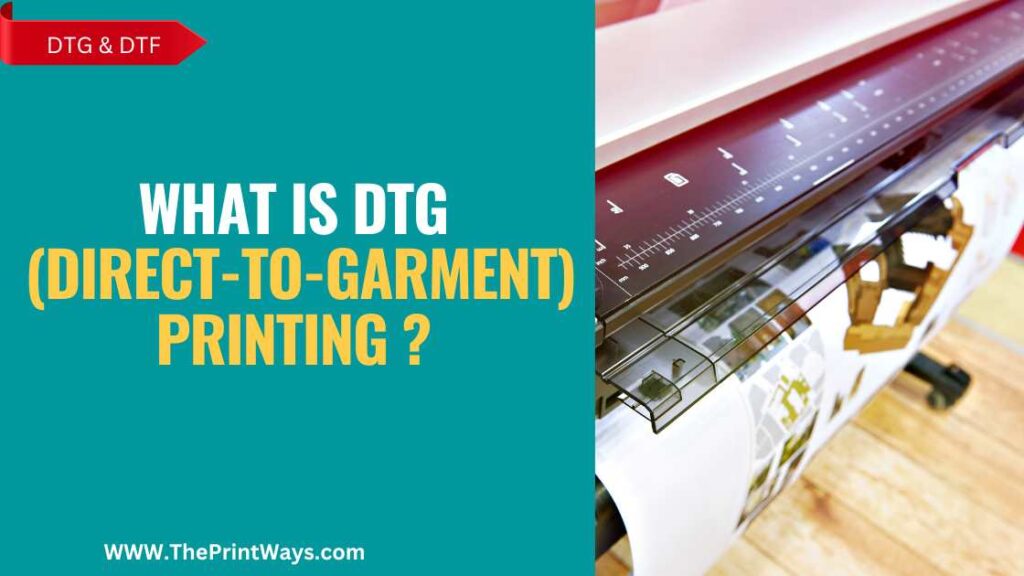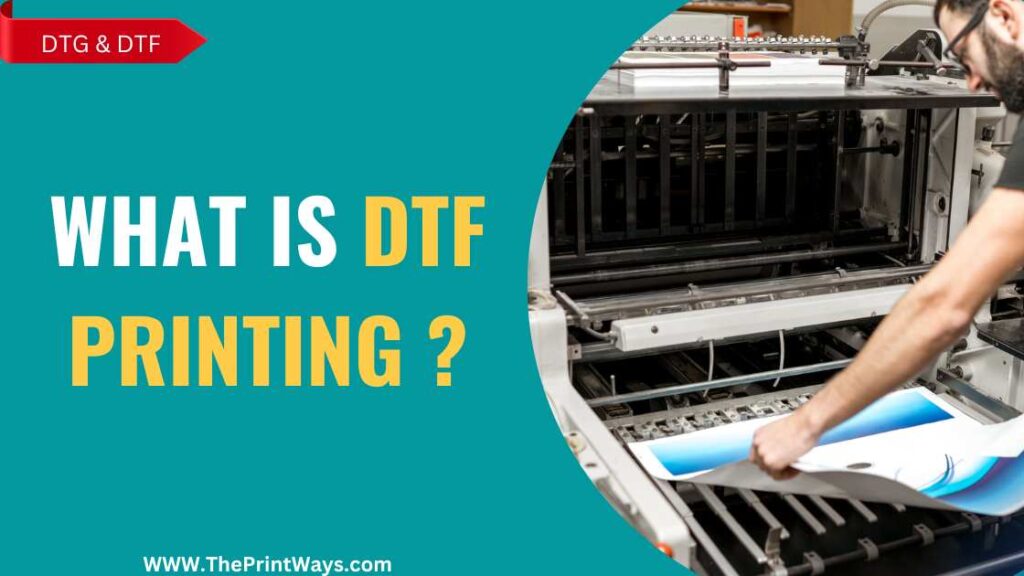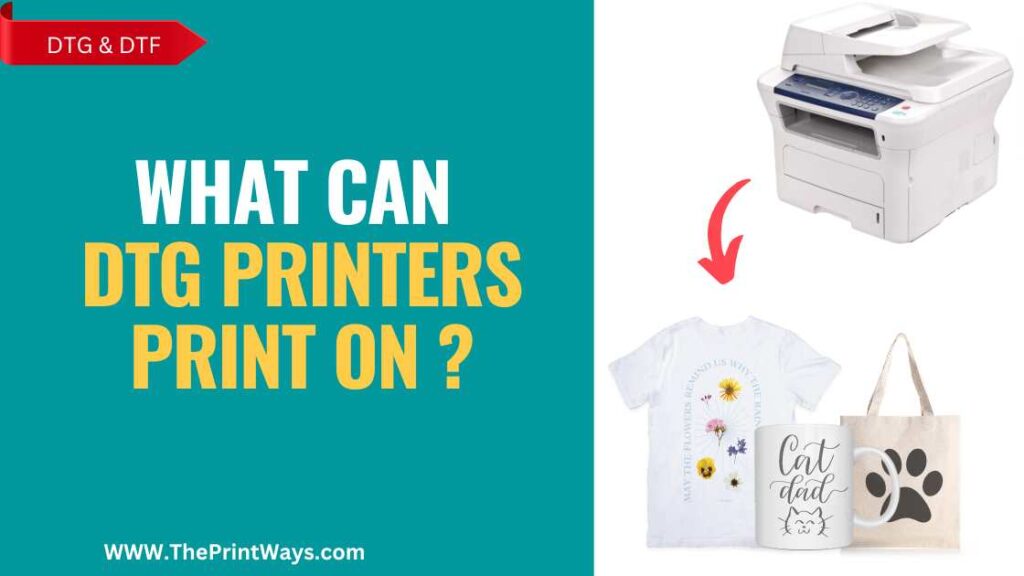Technology and methods for digital printing are constantly developing and improving. DTF (Direct to Film) printing and sublimation printing are two of the most common printing techniques.
Both techniques have advantages and disadvantages and can yield stunning results; the question is which is best for your printing business. We will examine the DTF vs Sublimation debate in detail by contrasting the two processes’ procedures, tools, and outcomes and also check the in depth difference between sublimation and dtf.
What is DTF Printing?
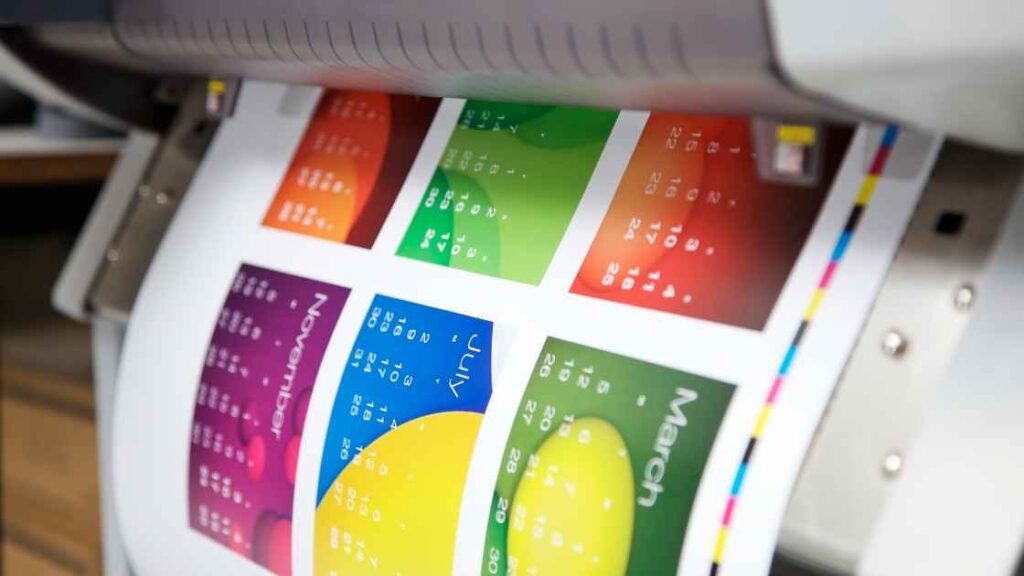
A relatively new printing technique called DTF (Direct to Film) printing has recently swept the printing industry. Printing a design onto heat-sensitive film with a special printer is the first step in transferring that design to fabric through heat and pressure.
The ink is fixed to the fabric by the film’s adhesive powder layer, resulting in a long-lasting and high-quality print.
Printing the design onto a thin film using a DTF printer is the first step in making a DTF print. The printer uses specifically formulated inks to ensure a strong bond between the adhesive powder on the film and the printed image.
Related Post: Infusible ink (Cricut) Vs Sublimation ink : How does each work?
The printed design is transferred to the fabric with the help of a heat press. The heat and pressure of the press activate the adhesive powder on the film, bonding it to the fabric in a way that cannot be undone.
Main Difference between Sublimation and DTF: DTF involves printing on a film and transferring to fabrics, while sublimation prints on transfer paper and transfers to materials like polyester, ceramics, and metal through a gas bonding process.
What Equipment is Needed for DTF Printing?
The following materials are required to begin DTF printing:
1. DTF Printer: A direct-to-film printer, or DTF printer, is a special printer designed specifically for printing on film. The film’s adhesive powder reacts with the printers’ unique inks to form a strong bond.
2. DTF Transfer Film: DTF film, or dry transfer film, is a specialized film with an adhesive powder coating. The fabric receives the pattern from the film.
3. Heat Press: A heat press transfers the design from the DTF film to the fabric. In a heat and pressure press, the adhesive powder on the film bonds to the fabric.
What are the Advantages of DTF Printing?
Many advantages come with DTF printing, such as:
- The prints made with DTF printing are of the highest quality and will not fade or crack over time.
- In addition to cotton and polyester, DTF printing can be used on various other fabrics.
- Regarding small print runs, DTF printing is a cost-effective solution.
- User-Friendly: To use DTF printing, you need neither experience nor training.
What are the Disadvantages of DTF Printing?
However, DTF printing has a few drawbacks:
- Because current DTF printing technology only supports the CMYK color space, it may not be suitable for designs requiring a more diverse color palette.
- DTF printing takes longer to transfer the design to the fabric than other methods, such as sublimation.
- DTF printers and heat presses can be more expensive than other types of printing equipment to purchase.
What is Sublimation Printing?
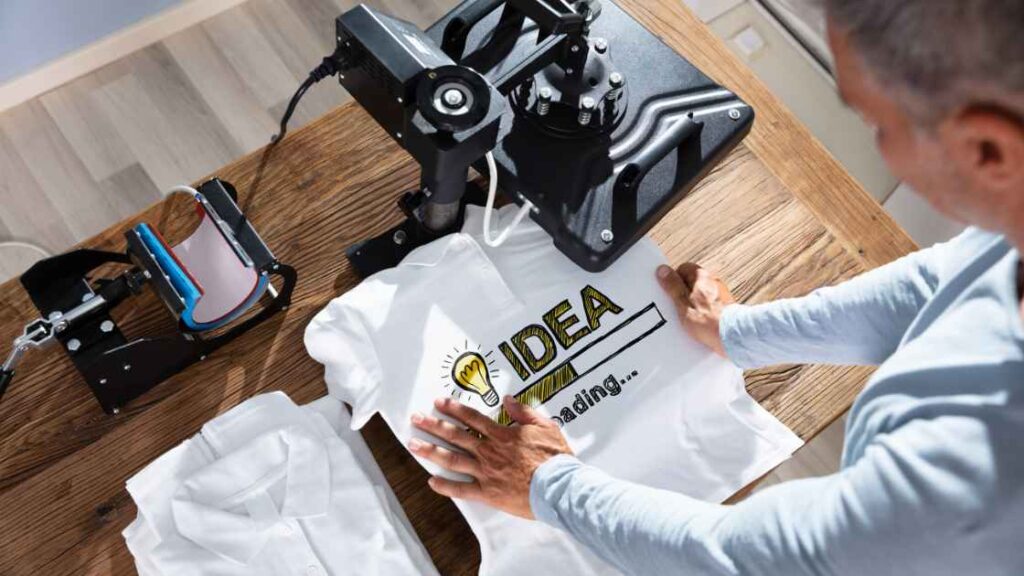
Sublimation printing involves pressing a heated substrate into a cold one and transferring the image from the heated substrate to the cold one. After printing with sublimation inks onto transfer paper, the design is transferred to the substrate.
A permanent, high-quality print is produced when the ink is heated and compressed to the point that it sublimates into a gas and bonds with the substrate.
Also Read: Pigment Ink Vs Sublimation Ink: What’s the difference?
First, transfer paper and sublimation inks are used to print the design. After the printed design has been transferred to the substrate, it is pressed firmly using a heat press. When the ink on the transfer paper sublimates or turns to a gas and then bonds with the substrate, a permanent, high-quality print is created.
What Equipment is Needed for Sublimation Printing?
You’ll need the following materials to get started with sublimation printing:
1. Sublimation Pinter: The sublimation printer is a unique equipment designed to print exclusively with sublimation inks. Sublimation ink, used by the printer, turns into a gas when exposed to heat and pressure.
2. Sublimation Ink: Sublimation ink is a special ink that evaporates into gas in high heat and pressure. The pattern is inked up and printed on transfer paper.
3. Transfer Paper: Paper with a special coating transfers the design to the substrate. The design is printed onto transfer paper using sublimation rather than regular ink.
4. Heat Press: The design can be transferred from the transfer paper to the substrate using a heat press. Sublimation ink is activated in the press by applying heat and pressure. At this point, it changes phase into a gas and bonds to the substrate.
What are the Advantages of Sublimation Printing?
Using sublimation printing has several benefits, including:
- Broad color spectrum: Sublimation printing can produce a broad spectrum of colors and print vivid, high-quality images with excellent detail.
- Durability: Sublimation prints hold up well over time and resist cracking and fading.
- Versatility: Various substrates, including polyester, ceramics, metal, and more, can be printed with sublimation technology.
- Timely design transfer: Sublimation printing is a great option for longer runs because it has a quick and effective design transfer onto the substrate.
What are the Disadvantages of Sublimation Printing?
However, there are a few drawbacks to sublimation printing:
- Few potential printing surfaces exist since sublimation printing is only permitted on polyester-coated substrates. As a result, not all substrates may be compatible.
- Sublimation printing can be more expensive than other printing techniques because it requires a heat press and sublimation printer.
- Polyester and polyester blends are the only textiles that can be printed using sublimation.
DTF vs Sublimation: Comparison
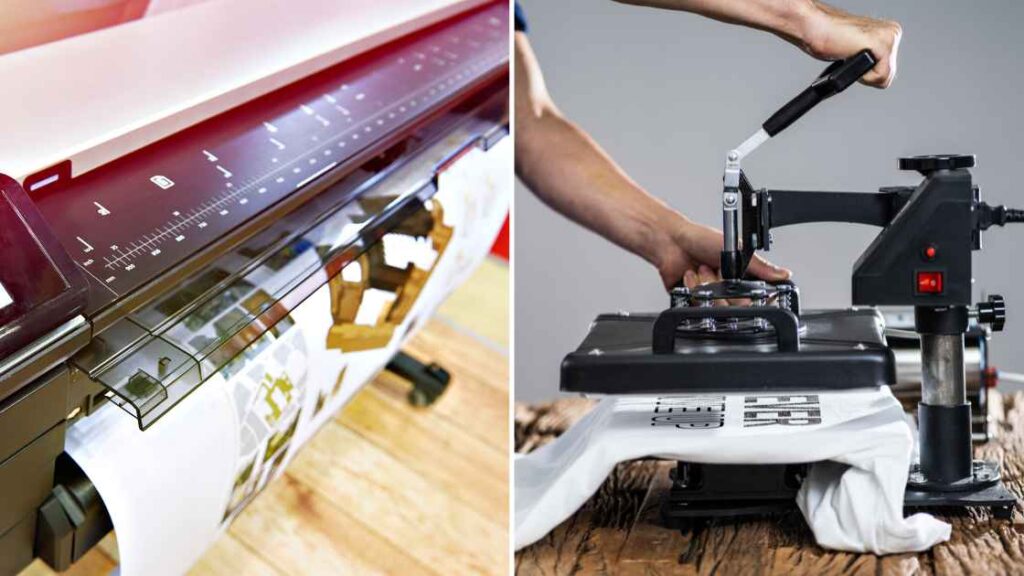
We have compared the processes and equipment used for DTF and sublimation printing. We can now conclude which is superior in output quality, cost, and adaptability.
Final Results
Both direct-to-fabric (DTF) and sublimation printing have the potential to produce long-lasting prints of exceptional quality. Sublimation printing, on the other hand, can make an extremely wide range of colors and intricate designs. In contrast, DTF printing might better suit simpler designs with fewer colors.
Cost
Direct-to-fabric printing (DTF) typically costs less than sublimation printing, especially for smaller orders. DTF printers and heat presses may cost more than sublimation printers and heat presses.
Versatility
Although DTF and sublimation printing offer many leeways, they each have drawbacks. DTF printing is suitable for a wider range of fabrics than sublimation printing, which is limited to polyester and polyester blends.
With sublimation printing, you’re not limited to just fabric like direct-to-fabric printing (DTF), but rather a wide range of substrates like ceramics, metal, and more.
Which should you Choose?
The choice between DTF and sublimation printing is ultimately yours. If you need to print on a variety of fabrics (such as cotton and blends), but your designs only use a small number of colors, direct-to-fabric printing (DTF) could be the way to go.
But suppose you need to print on polyester fabrics and blends and want to create vivid, detailed designs. In that case, sublimation printing may be your best bet.
Also Read: Can you use sublimation ink for Regular printing?
When deciding between the two approaches, it’s also important to consider how much money you’ll need to invest in equipment and the difference between sublimation and dtf.. DTF printing may be less expensive than sublimation printing for short runs. Still, the equipment costs associated with it can add up.
Sublimation printing is more flexible in terms of substrates. In contrast, direct-to-fabric printing (DTF) is more flexible regarding fabrics.
Which method, DTF or sublimation printing, is best for you depends on your unique circumstances. Both approaches have benefits and drawbacks; choose the one that best suits your professional or personal printing needs.
DTF Ink Vs Sublimation Ink: Which should you use?
Your particular printing requirements and the kind of substrate you are printing on ultimately determine whether you should use DTF ink or sublimation ink.
While sublimation ink can only be used on polyester and blends of fabrics, DTF ink is made to print on a wider variety of materials, including cotton. On darker fabrics, DTF ink tends to produce more vivid and brighter colors because it is more opaque.
However, sublimation ink creates vivid, highly detailed designs on various substrates. The decision between DTF ink and sublimation ink ultimately depends on your unique requirements and your printing material.
Frequently Asked Questions
Q: What is the difference between Sublimation and DTF?
Sublimation printing involves heat-sensitive ink, which, when subjected to heat and pressure, changes phase from liquid to gas and bonds with the substrate, resulting in a permanent print.
In direct-to-film (DTF) printing, special printer prints directly onto a transfer film, which is then applied to the substrate and pressed firmly. While sublimation printing can only print on polyester and polyester blends, DTF printing can print on a wider variety of fabrics, including cotton. Thats the main difference between sublimation and dtf.
Q: Is DTF better than sublimation?
Your printing needs and specifications will determine the best option. While sublimation printing creates vivid, detailed designs and is limited in substrate options, direct-to-fabric (DTF) printing can be used on various fabrics (including cotton). It may be more cost effective for small runs.
Ultimately, it will come down to your preferences and financial situation to determine which option is best.
Q: DTF printer vs sublimation: Which is better?
Again, Your printing needs and budget will determine which type of printer is best for you. Sublimation printers use heat-sensitive ink to create a gas that bonds with the substrate to create a permanent print. In contrast, DTF printers print directly onto transfer films.
While sublimation printers are limited in the substrates they can print on, they are capable of printing on a wider variety of materials and can create designs with greater color saturation and detail than direct-to-fiber (DTF) printers.
Q: DTF transfer vs sublimation transfer: Which is better?
The transfer method you choose depends on your printing needs. Printing directly onto a transfer film, which is then placed on the substrate and held in place with heat and pressure, is DTF transfer.
Sublimation transfers involve printing onto transfer paper, placing it on the substrate, and applying heat and pressure to bond the ink to the substrate. Sublimation transfers produce vibrant, detailed designs and can be used on a wider range of substrates. Still, DTF transfers are cheaper for small runs and can print on cotton.
Final Thoughts
In conclusion, direct-to-film (DTF) printing and sublimation printing are efficient methods that yield high-quality, long-lasting prints. Each approach has its own pros and cons, so picking one will depend on your printing needs and budget. A firm grasp of the processes and tools required by each approach will allow you to pick the most suited to your specific needs.

